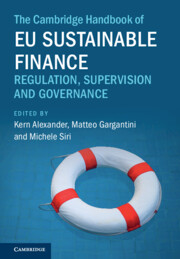Book contents
- The Cambridge Handbook of EU Sustainable Finance
- The Cambridge Handbook of EU Sustainable Finance
- Copyright page
- Contents
- Figures
- Tables
- Contributors
- Preface
- Acknowledgements
- Part I Introduction
- Part II Ethics and Sustainability in Corporate Law, Corporate Governance and Conduct
- Part III Integrating Sustainability in Financial Markets Regulation
- Part IV Ensuring Financial Stability and Sustainability
- Part V Financial Innovation and Sustainability
- 25 Can Financial Regulation Truly Support the Reduction of CO2 Emissions?
- 26 Climate Risk and Financial Markets
- 27 The Skin-in-the-Game Bond
- 28 Financial Innovation in the Process of Financial Inclusion
- 29 Sustainable Finance and Fintech
- Index
- References
26 - Climate Risk and Financial Markets
The Case of Green Derivatives
from Part V - Financial Innovation and Sustainability
Published online by Cambridge University Press: 30 January 2025
- The Cambridge Handbook of EU Sustainable Finance
- The Cambridge Handbook of EU Sustainable Finance
- Copyright page
- Contents
- Figures
- Tables
- Contributors
- Preface
- Acknowledgements
- Part I Introduction
- Part II Ethics and Sustainability in Corporate Law, Corporate Governance and Conduct
- Part III Integrating Sustainability in Financial Markets Regulation
- Part IV Ensuring Financial Stability and Sustainability
- Part V Financial Innovation and Sustainability
- 25 Can Financial Regulation Truly Support the Reduction of CO2 Emissions?
- 26 Climate Risk and Financial Markets
- 27 The Skin-in-the-Game Bond
- 28 Financial Innovation in the Process of Financial Inclusion
- 29 Sustainable Finance and Fintech
- Index
- References
Summary
The European financial markets have been placed on the path to a sustainable and green transition. The European Commission embraced with the EU Green Deal a new growth strategy built on a sustainable economic model that aims at making the EU the first carbon neutral continent by 2050. This generational economic and industrial transition set by the EU Green Deal will require at least 1 trillion euro in public and private sustainable investments. This chapter analyzes how derivatives markets can contribute to support the green transition, enable private markets to raise capital towards sustainable goals, and help market participants to manage the market and transition risk to a sustainable economy. “Green derivatives” like ESG- linked swaps, emission allowance futures, extreme weather events derivatives, are examples of financial innovation is dealing with climate-related risk. This chapter focuses on the EU Strategy for Financing the Transition to a Sustainable Economy in the EU and offers a looks at what the Commodities Futures Trading Commission is doing in the US on climate-related risk and derivatives markets. The chapter offers some early critical considerations on the private-public synergies and opportunities that might result from the growth and expansion of sustainable derivatives markets and the possible risks that policymakers should consider in the evolution process of such markets.
Keywords
- Type
- Chapter
- Information
- The Cambridge Handbook of EU Sustainable FinanceRegulation, Supervision and Governance, pp. 663 - 685Publisher: Cambridge University PressPrint publication year: 2025

